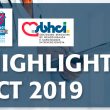Courtesy of the SBHCI. Monotherapy with a P2Y12 inhibitor after a minimum period (3 months) of dual antiplatelet antiaggregation (DAPT) is a valid treatment option to reduce bleeding in patients at high risk of bleeding complications. The present double-blind study presented at TCT 2019 simultaneously published in NEJM analyzed ticagrelor monotherapy (prior 3 months DAPT)...
ESC 2019 | New European Guidelines on “Chronic Coronary Syndromes”
In Paris, during the European Society of Cardiology (ESC) Congress 2019 Scientific Sessions, new guidelines for the diagnosis and treatment of chronic coronary syndromes were presented. This document, simultaneously published in Euro Heart J, updates the 2013 guidelines on stable ischemic heart disease and takes out the word “stable” so as to emphasize that the...
ESC 2019 | CONDI-2ERIC-PPCI: Final Blow Against Ischemic Pre-Conditioning in Primary Angioplasty
Remote ischemic conditioning does not offer any clinical benefit to patients with ST-segment elevation acute myocardial infarction undergoing primary angioplasty, according to this study presented on Sunday at the European Society of Cardiology Congress 2019. Prior studies were limited and small, but this analysis seems to provide definitive evidence with regard to ischemic pre-conditioning. The...
Experts Reach Consensus on Post TAVR Pacemaker Indication
This new consensus published this week in J Am Coll Cardiol has provided us with an algorithm to manage conduction disturbances after transcatheter aortic valve replacement. This consensus is intended to reduce potential deaths caused by conduction disturbances and, at the same time, reduce unnecessary definite pacemaker implantation. This document is a big step ahead...
ESC 2019 | PARAGON-HF: Sacubitril/Valsartan Somewhat Disappointing, though a Few Would Benefit.
The combination Sacubitril/valsartan did not reduce the risk of rehospitalization for heart failure or cardiovascular death in patients with cardiac failure symptoms and preserved ejection fraction, according to the new study presented on Sunday at ESC 2019 scientific session in Paris and simultaneously published in NEJM. Despite the negative results, we remain hopeful that this...
ESC 2019 | POPULAR AGE: Good Old Clopidogrel Still Valid
According to this study, presented during the ESC 2019 scientific sessions, non-ST acute coronary syndrome (NSTE-ACS) patients treated with ticagrelor presented a significantly higher risk of bleeding than patients treated with clopidogrel, with no counterbalance by higher benefit in thrombotic events. Researchers suggest clopidogrel might be the gold standard for this elderly NSTE-ACS population, though...
Can Antiplatelet Therapy Affect the Life of Coronary Grafts?
The antiplatelet treatment strategy providing optimal balance between thrombotic and bleeding risks in patients undergoing myocardial revascularization surgery is unclear. What does seem somewhat certain is that some antiplatelet therapy is necessary to prevent early thrombosis, mainly in vein grafts, but (as opposed to what happens with angioplasty) there are other relevant factors such as...
PCI and Anticoagulation: What is the best strategy?
Most patients with atrial fibrillation require anticoagulation to reduce the risk of stroke or systemic embolization. Today, this is achieved with the new direct oral anticoagulants, which present lower intracranial bleeding risk compared against the old vitamin K antagonists. On the other hand, approximately between 5% to 10% of patients receiving PCI also present atrial...
After Much Toing and Froing, Gastrointestinal Protection Is Back to the Forefront
Several clinical guidelines differ in their recommendation regarding the prescription of proton pump inhibitors to patients being treated with dual antiplatelet therapy after infarction. In 2015, the European Society of Cardiology (ESC) recommended their use in patients with high bleeding risk; however, in the 2017 update that recommendation became general after the assumption that, for...
Aspirin in Primary Prevention: Another “Trendy” Topic in Publications
Aspirin is the standard treatment when it comes to optimal medical treatment in the context of secondary prevention of coronary artery disease, in patients with diagnosed, established atherosclerosis. Even though bleeding risk is rather small in the short period an acute event takes place, it increases substantially over time. However, the evidence clearly supports the...









